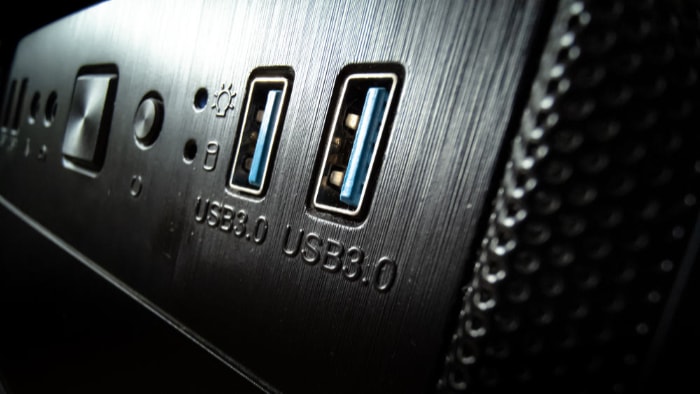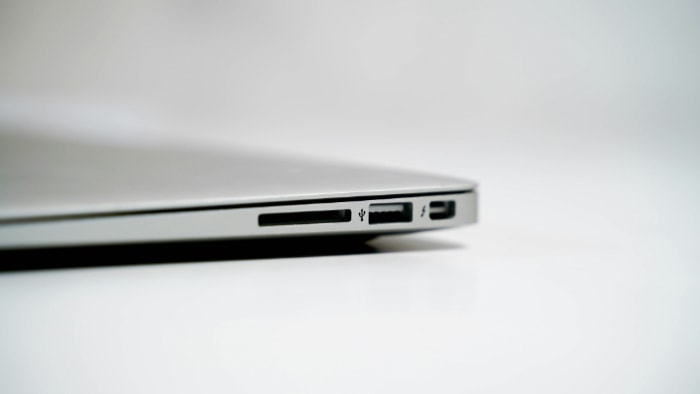Blue vs. Black USB Ports: Picking the Right Port

USB ports are like the unsung heroes of our tech-savvy world, subtly yet significantly influencing our daily digital interactions. They're the lifelines that connect our gadgets, charge our devices, and ensure our data flows seamlessly from one device to another. However, not all USB ports are created equal.
With a simple glance at your laptop or desktop, you might notice USB ports flaunting different colors, predominantly blue and black. This color coding isn't just for show; it signifies distinct capabilities that can drastically impact your tech experience.
Black USB Ports: The Universal Standard
Black USB ports represent the classic interface that set the standard for connectivity in the digital age. These ports, commonly found on a myriad of devices, symbolize the USB 2.0 era – a time when syncing devices and transferring data first became a part of everyday life.
Historical Context and Dominance
The emergence of USB 2.0 marked a revolutionary leap from its predecessor, USB 1.x, offering enhanced speed and performance. Black USB ports became synonymous with this standard, providing a reliable and consistent connection for an array of devices.
Their prevalence across gadgets of all kinds solidified their position as the go-to interface for users worldwide.
Technical Specifications
USB 2.0, represented by black ports, boasts a maximum data transfer speed of 480 Mbps. While this may not compete with the speeds offered by newer standards, it’s sufficient for many everyday tasks such as file transfers, peripheral connectivity, and basic streaming.
Furthermore, the power delivery capability of these ports ensures that your devices stay charged and ready for action.
Compatibility Considerations
One of the strengths of black USB ports lies in their backward compatibility. Devices and cables designed for newer USB standards can often connect to black ports without issue, although they will operate at USB 2.0 speeds.
This versatility makes black USB ports a reliable choice for a wide array of devices, ensuring connectivity regardless of the specific USB generation.
Common Uses
Black USB ports are commonly used for connecting peripherals like keyboards, mice, and webcams, which don't require high-speed data transfer. They also serve as charging points for a myriad of devices, from smartphones to tablets, providing a steady power supply for charging and operation.
The Legacy of Black USB Ports
Despite the advent of faster, more advanced USB standards, black USB ports continue to hold significant value in the tech ecosystem. Their universal presence across devices and their ability to cater to a broad spectrum of needs make them an enduring standard, one that continues to serve users across the globe efficiently.
Blue USB Ports: The SuperSpeed Pioneers
Blue USB ports are not just visually distinctive; they are technological trailblazers, marking a significant leap forward in the evolution of USB technology. These ports signify the USB 3.x standard, known for its remarkable speed and enhanced power delivery.
They are designed to meet the demands of modern digital life, from rapid file transfers to efficient device charging.
Introduction to USB 3.x Standards
USB 3.x, represented by blue-colored ports, was introduced as a response to the growing need for faster data transfer rates and improved functionality. With this standard, data transfer and device charging are not just faster but also more efficient, catering to the increasing data demands of modern users.
The introduction of USB 3.x was a game-changer, setting new benchmarks for speed and performance in the USB technology realm.
Technical Enhancements and Speed
Blue USB ports, synonymous with USB 3.x standards, boast impressive data transfer rates, significantly higher than their USB 2.0 counterparts. With speeds reaching up to 5 Gbps for USB 3.0 and even higher for later versions like USB 3.1 and USB 3.2, these ports are well-suited for data-intensive tasks such as HD video streaming, gaming, and large file transfers.
The enhanced power delivery also ensures quicker charging times and more efficient power management.
Visual Identification and User Convenience
The distinct blue color of these ports is not just for aesthetics; it serves a practical purpose. It allows users to easily identify and utilize the high-speed capabilities of their devices without confusion.
This visual cue ensures that users can effortlessly connect their devices to the appropriate port, optimizing their digital experience and making the most of the available technology.
Compatibility and Backward Compatibility
While blue USB ports are designed for optimal performance with USB 3.x compatible devices, they also offer backward compatibility. This means they can accommodate devices and cables from older USB standards, although the performance will align with the capabilities of the connected hardware.
This feature ensures a broad compatibility range, making blue USB ports versatile connectors in a diverse technological landscape.
The Role of Blue USB Ports in Modern Tech
Blue USB ports have become synonymous with high-speed data transfer and efficient power delivery. They are integral to the functionality of modern gadgets and devices, catering to the ever-increasing demand for quick and reliable digital connectivity.
Whether it's for professional use, gaming, or general multimedia consumption, blue USB ports provide the necessary speed and power, proving themselves as indispensable components in today's digital age.
Beyond Colors: Additional USB Port Variants

While the classic black and the faster blue USB ports are the most common, the USB universe is more diverse than these two colors suggest. The evolution of USB technology has introduced a palette of port colors, each indicating unique capabilities and specifications.
Red USB Ports: Always On, Always Ready
Red USB ports stand out not just for their vibrant color but also for their special feature: they remain powered on even when the computer is turned off or in sleep mode. This feature is particularly useful for charging devices like smartphones and tablets, ensuring that your devices get charged even when your computer isn't actively in use.
The ‘sleep-and-charge' feature of red USB ports exemplifies the thoughtful integration of user convenience in USB technology.
Yellow USB Ports: Optimized for Charging
Yellow USB ports, often seen on laptops and desktops, are specifically optimized for charging devices. They provide more power compared to standard USB ports, ensuring quicker and more efficient charging.
These ports are particularly handy when you need to quickly boost your device's battery life, proving that USB technology isn't just about data transfer but also about meeting the power needs of modern devices.
Teal USB Ports: The USB 3.1 Gen 2 Standard
Teal USB ports signify the presence of USB 3.1 Gen 2 technology, a further advancement in the USB 3.x series. These ports offer even higher data transfer speeds, reaching up to 10 Gbps.
This doubling of speed compared to the standard USB 3.x ports makes teal ports ideal for extremely data-intensive tasks, pushing the boundaries of what USB technology can achieve in terms of speed and performance.
The Importance of Recognizing Port Variants
Understanding the nuances of these USB port colors and their corresponding capabilities is crucial for optimizing your digital experience. Recognizing the right port for your specific need – whether it's high-speed data transfer, efficient charging, or data access during sleep mode – can significantly enhance your interaction with your devices.
It ensures that you are not just using the technology, but are maximizing its potential to suit your lifestyle and digital demands.
Embracing the Diversity of USB Technology
The variety of USB port colors is a testament to the evolving nature of technology, adapting to the multifaceted needs of users. From the standard black USB 2.0 ports to the fast blue USB 3.x ports, and the specialized red, yellow, and teal variants, each color tells a story of innovation and user-centric design.
Understanding these colors and their significance allows users to navigate the digital world more efficiently, making informed choices that align with their specific technological needs.
Practical Implications: Choosing the Right Port for Your Needs
In the vast landscape of USB technology, knowing the differences between port types isn't just trivia—it's a practical skill that can drastically improve how you interact with your devices. Whether you're a professional needing efficient data transfer, a gamer requiring swift and reliable connectivity, or just someone looking to charge your devices efficiently, choosing the right USB port for your needs is crucial.
Assessing Your Needs: Speed, Power, or Both?
Start by evaluating what you primarily need from your USB port. If you're frequently transferring large files or need quick access to your data, a blue or teal USB port (USB 3.x or USB 3.1 Gen 2) will serve you best, offering high-speed data transfer rates.
On the other hand, if charging devices is your priority, a yellow or red USB port might be more suitable, providing optimized charging capabilities or the convenience of ‘sleep-and-charge.'
Compatibility Is Key
While it's tempting to always opt for the fastest option, compatibility is a critical factor. Check the specifications of your devices and peripherals to ensure they match the USB port you plan to use.
Remember that while newer USB standards are backward compatible, you'll only achieve the maximum speed and efficiency if the device, cable, and port are all aligned with the same standard.
Balancing Speed with Power
Some modern devices require both high-speed data transfer and significant power delivery. In such cases, look for ports that can deliver on both fronts.
For instance, teal USB ports (USB 3.1 Gen 2) offer not just faster data transfer rates but also improved power delivery compared to their predecessors.
Future-Proofing Your Connectivity
In a rapidly evolving digital world, opting for the latest technology can be a wise decision. Even if your current devices do not fully utilize the capabilities of the latest USB ports, choosing a laptop or a motherboard with these ports can save you from needing upgrades in the near future as your tech needs evolve.
The Big Picture: A Holistic Approach to USB Connectivity
Remember, the right port is not just about the individual task at hand but also about how it fits into your overall digital ecosystem. Consider how each device interacts with others and choose ports that not only meet your current needs but also offer flexibility for future devices and requirements.
This holistic approach ensures a seamless and efficient digital experience, leveraging the full potential of USB technology to serve your specific needs.
Conclusion
Embarking on a journey through the colorful world of USB ports reveals more than just a spectrum of hues; it unveils a narrative of technological evolution tailored to our ever-growing digital demands. The black and blue USB ports, alongside their red, yellow, and teal counterparts, aren't mere design choices but symbols of versatility and innovation.
Each color encapsulates a set of capabilities, inviting users to make informed decisions that resonate with their specific digital lifestyles, be it for professional endeavors, gaming escapades, or everyday tech interactions.
Recognizing the significance behind these colors transforms the way we interact with our devices, elevating our digital routines from mundane tasks to optimized experiences. It's a journey that encourages not only understanding but also appreciation for the intricate details that define our technological landscape.
By choosing the right port for the right task, we're not just connecting devices; we're weaving efficiency, speed, and power into the very fabric of our digital lives.


